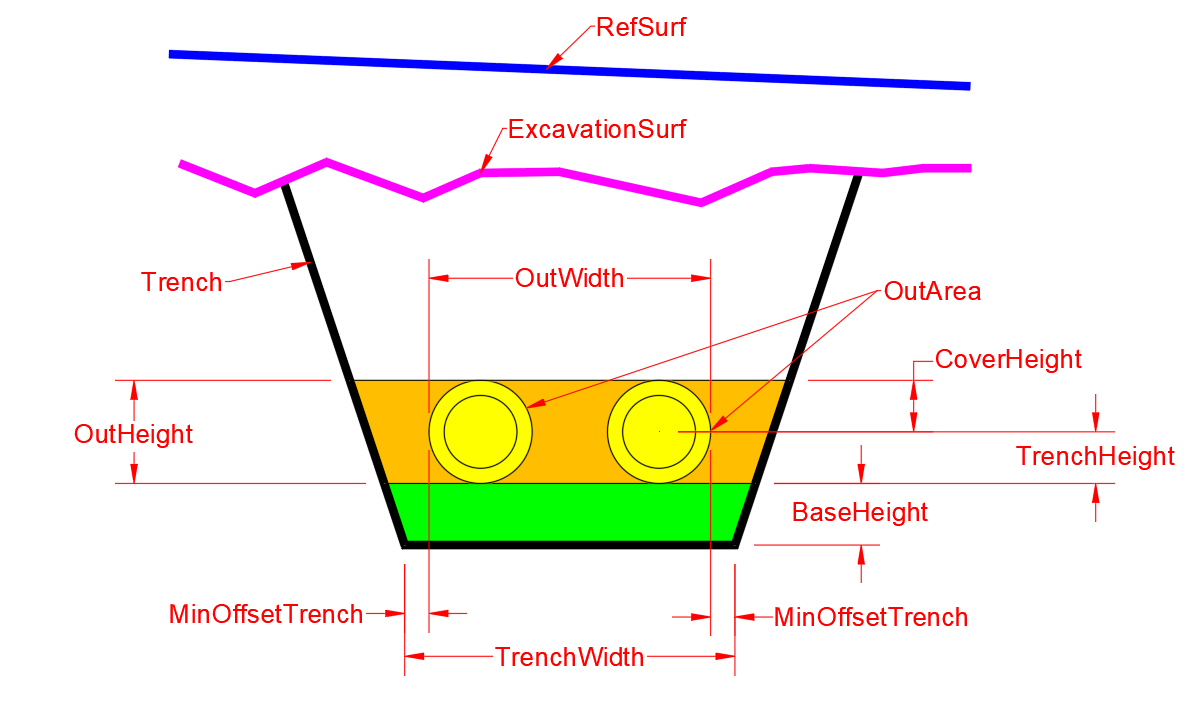Required Properties
Required Properties are those properties defined by the Constructor and not by the User in the frame Property Creation.
These properties are used internally by the SOLIDOS program for various purposes, such as excavation calculation, network numbering, device positioning, etc. Are the following:
- All types
- Existing (Existent) - indicates whether the device is existing or designed
When the device is existing, it is not possible to change its geometry or section, even if the surface changes
Note, the constructor does not modify this property on the device, even if in the model implementation, there is an activity
 Set Parameter to the property
Set Parameter to the property
- Code (Code) - a short text that identifies the device easily in catalogs, for example:
- PV - manhole
- CL - link box
- CI - inspection box
- BL - culvert
- TL - cleaning terminal
- BSTC - simple tubular concrete culvert
- BDTC - double tubular concrete culvert
- BTTC - triple tubular concrete culvert
- BSRC - simple rectangular concrete manhole
- BDRC - double rectangular concrete manhole
- BTRC - triple rectangular concrete manhole
- PVC - PVC pipe
- Calculate - Indicates that the modeler will process some hydraulic calculation, without modeling geometries
- TempEnts - indicates that the modeler will process temporary entities
- RunOption - Used to enable the use of redundant properties
Different properties that control the same characteristic of the device, for example: the depth of the bottom and the height of the manhole. The bottom dimension controls the height indirectly
It appears in the Property Creation frame to enable testing during modeling.
Expected values for this property: The name of the property changed on the device that caused the reshape
All tools that draw grip points on the device report the name of the property configured in the Parameter Name field:

- Ignore Adjustment (IgnoreSurfAdj) - indicates whether the device ignores surface elevation
It might be:
- True - surface elevation is ignored and user must provide device elevation manually
- False - the elevation of the device is corrected if its position changes or the elevation on the surface changes. As long as the device is not set to Existing
- Point Devices
- Insertion Point (Location) - this property should not be changed during modeling
Only appears here to facilitate calculations and checks
- Trench Height (TrenchHeight) - External height of the device, used to calculate the elevation of the trench bottom.
In general it is: (Top Elevation) - (Ditch Bottom Elevation)
In the manhole model, it is equal to: TrenchHeight = Height + Floor
- Solid Volume (SolidVolume) - volume of solid that is effectively buried, used in the calculation of the backfill of the trench
Usually the outer volume of the device unless Superelevation cannot be disregarded
- Linear/Longitudinal Devices
- Trench Height (TrenchHeight) - Height between the reference axis and the bottom of the trench, used to calculate the excavation.
In the model of circular pipes it is given by (Radius of the internal section)+ (Wall Thickness), with the axis at the center of the section
- AxisDistance (Axis Distance) - Distance from the construction axis to the lowest point of the hydraulic section

- Reference axis (Axis3D) - aids in modeling and is used to calculate the position of the cross section to be excavated
Linear devices require a reference axis for the calculation of the excavation, the cover and the device modeling itself
- Hydraulic Section (HydraulicSection) - Used to do hydraulic calculations, should be a polyline for open sections (culverts, gutters), or a region (or closed polyline) for closed sections (pipes, galleries)
- Manning Coefficient (ACMan) - Used to make hydraulic calculations, material dependent
- Out Height (OutHeight) - Used in excavation calculations:

- Outer Width (OutWidth) - Used in excavation calculations
- Out Area (OutArea) - Used in excavation calculations
- Cover Height (CoverHeight) - Used in excavation calculations
- Displace Ditch (DisplaceDitch, Double) - Displaces the axis of the ditch relative to the axis of the device
Positive values shift right and negative values shift left

- Start Connector Filter (StartConnectorFilter) - text that will be used to filter the
 connector
when choosing the closest one
connector
when choosing the closest one
- End Connector Filter EndConnectorFilter() - text that will be used to filter the
 connector
when choosing the closest one
connector
when choosing the closest one
- Linear Devices
- Start Point (StartPoint) - for defining the reference axis
- End Point (EndPoint) - for defining the reference axis
- Pipe Lines (PipeLines) - Used to divide the flow flowing into each section
- Longitudinal Devices
- Arc Length (ArcLength) - length of the fillet arc modeled on the vertices
- Minimum Radius (MinRadius) - minimum radius of the fillet arc, can increase the arc length
- Points (Points) - list of points used to model the axis of the device
 Set Parameter to the property
Set Parameter to the property




 connector
when choosing the closest one
connector
when choosing the closest one connector
when choosing the closest one
connector
when choosing the closest one